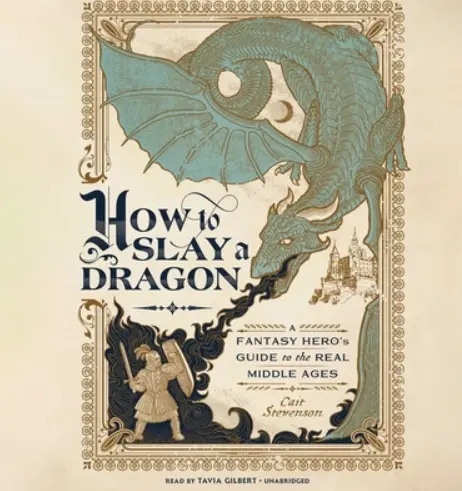HOW TO SLAY A DRAGON

# HOW TO SLAY A DRAGON: A Fantasy Hero’s Guide to the Real Middle Ages
In the medieval era, where swords and sorcery once reigned supreme, tales of dragons and warriors have captured the imagination. People yearn for the medieval times much like they long for the idyllic countryside—a utopia that exists solely in the realm of imagination.
Strangely enough, there are those who find solace in pursuing a different path, even if it leads them astray—people like myself, who revel in the unconventional. Such individuals find joy in this “quirky” compendium.
What I mean to say is, if you’re not the type to delve into “strict history” or merely a gamer seeking entertainment, then perhaps you’re the kind to seek philosophy in games and dark humor in history. Well, congratulations, you’re ready to embark on your journey through the medieval world.
This book is not suited for those seeking a detailed understanding of the medieval period. It follows the main theme of “heroic dragon-slaying role-playing,” presenting popular medieval tales and literature in a digestible format. This implies that there’s no obligation to provide a comprehensive educational framework covering the economic, cultural, and political aspects of the era.
Unlike traditional history books that offer analytical viewpoints, this book occasionally offers the author’s perspective on the use of historical sources. Are laws reliable? People of that time didn’t necessarily follow them; the focus lies more on exploring the motives behind lawmaking. Are diaries sincere? Many medieval individuals clandestinely recorded their mastery of magic or their various exploits, yet some narratives and their subsequent personal records harbor hidden contradictions.

This book primarily focuses on elucidating the everyday aspects of life during the medieval period:
- From unicorns to the fantastical creatures of the time,
- From troubadours to the ballads of the era,
- From cursed marshes to poorly managed latrines,
- From courtship to the moral codes of the time.
It delves into topics such as medieval bathroom practices, dental hygiene, road systems, inns, and even rustic romance. What captivates the reader is the contrast between the titles and the content, drawing them into the next intriguing chapter.
The examples provided by the author are remarkably close to life and imbued with humor. For instance, were there really records of religious miracles and magical occurrences in the medieval period? Indeed, there are documented instances of individuals keeping diaries (in the form of autobiographies) detailing their studies in magic, which were later studied by others—resulting in a profound sense of shame. As for the various daily occurrences in medieval life, the author doesn’t shy away from employing witty and satirical language. Take, for instance, the scenario of the three individuals in a duel, where the one who initially arrived naked ends up surviving—a lesson for all: “In the medieval times, always carry a weapon in secret.”
Regarding unclean neighbors, the sentiment is expressed as “Neighbors will be neighbors; they’re not cursed until their excrement blocks the streets, at which point perhaps they do become cursed—curses may be false, but filth is real.” And in the Byzantine Empire, where bizarre tragedies are anything but unusual, nothing seems out of the ordinary.
As the author doubles as a narrator and a guide through the adventures of the hero, these humorous remarks infuse the book with a strong sense of interactivity. Moreover, the titles themselves carry a distinct flavor reminiscent of Japanese anime RPGs.
While microhistory books like “Soulstealers: The Chinese Sorcery Scare of 1768” and “1587, a Year of No Significance: The Ming Dynasty in Decline” meticulously analyze individual historical records to support overarching themes, this book takes a different approach. Although the main storyline revolves around the adventures of dragon-slaying heroes, is there really a clear distinction between daily life and the grand narrative? This results in a somewhat vague understanding of the historical characteristics of the medieval period upon finishing the book, and the attempts at clarification seem more like gathering materials to fit preconceived notions.
Furthermore, I agree that the book comprises concise summaries of historical anecdotes, often densely packed with terminology, making the reading experience less than fluid.
For example, “He doesn’t proudly proclaim in the book how he transported these molds from Beirut to Damascus, then traveled north through Syria, crossed Anatolia to reach Constantinople, traversed the Balkan Peninsula to arrive in Vienna, and finally departed from Vienna, crossing the Holy Roman Empire to deliver them to the French king.” (This passage actually emphasizes the low reliability of the historical sources, doesn’t it?)
This book may indeed be overflowing with humor but lacks the element of astonishment when it comes to knowledge. When discussing the book’s content, all one can think of are the everyday adventures of characters like Little Shuai, Little Hei, and Buddha Bo Le—hardly a comprehensive exploration of medieval history!
However, rather than focusing solely on understanding medieval history, I appreciate the author’s enthusiasm conveyed through this approach. The author earnestly extends an invitation, expressing a genuine passion—inviting readers to see that the medieval era is an intriguing period, and history is a fascinating subject. It’s through this lens that patterns can be deduced and interpreted from seemingly trivial details, enticing people to delve into the realm of human knowledge.
Even in a medieval era devoid of dragons and swords and sorcery, one can still employ a framework of imagination to construct a historical perspective—from passion to creativity, and ultimately to history itself. In a medieval world without dragons, the stories brought back by triumphant warriors are rich with intriguing historical anecdotes.
